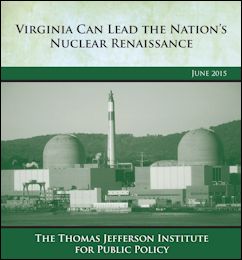Virginia can lead a national renaissance in nuclear energy, argue Robert Hartwell and Donald Hoffman in a new white paper published by the Thomas Jefferson Institute for Public Policy. They advance two main arguments: (1) nuclear is an economical source of green energy emitting near-zero levels of carbon dioxide, and (2) nuclear can support job creation and contribute to the tax base in Virginia.
As the Environmental Protection Agency’s Clean Power Plan compels Virginia to retire coal-fired power plants as the only practical way to meet strict CO2 emission goals, citizens face a critical decision whether or not to build a new nuclear power plant at Dominion Virginia Power’s North Anna nuclear facility. While Hartwell and Hoffman do not endorse the particulars of Dominion’s plans, they make the case that nuclear power is both safe and economical.
Neither Hoffmann nor Hartwell are disinterested parties. Hoffman chairs the Virginia Nuclear Energy Consortium Authority and Hartwell is president of Hartwell Capitol Consulting, which does work on energy and environmental issues. But as the debate over a third nuclear plant at North Anna heats up, they provide an advance look at how the pro-nuclear side will frame the debate.
Safety. Despite the impression created by highly publicized incidents like Chernobyl, Fukushima and Three Mile Island, nuclear power is safe, they assert. “There has never been a nuclear power accident in the United States resulting in radiation being emitted into the atmosphere.” Likewise, there have been “no accidents of any kind involving nuclear” in Virginia, including Dominion’s nuclear plants, dozens of nuclear-powered vessel, and experimental reactors at Fort Belvoir near Alexandria.
As for the North Anna nuclear plants being located on a fault line, they write:
During the 5.8 earthquake centered in Louisa County in August 2011, the North Anna 1 and 2 plants automatically shut down and were carefully checked before restarting nearly 90 days later. No damage occurred although some of the nuclear storage casks were moved closer together and some slid more than 4.5 inches.
Cost. Studies have found that nuclear power generated in Virginia was the least expensive of any power generation source. The cost per kilowatt hour was estimated at 0.6 cents compared to 3.5 cents for coal and 4.5 cents for natural gas. (The authors do not cite their sources for this data.)
Economic development. Aside from California, Virginia is the largest electricity importer among the 50 states. Moreover, the state will need more than 4,000 megawatts of additional power to meet the increased demand for electricity by 2021. Building power plants in Virginia creates jobs locally and bolsters the tax base.
Experts have found that the average nuclear power plant generates $470 million in sales of goods and services annually. One plant provides approximately $40 million in labor income each year and 400 to 700 full-time permanent jobs which pay 36% more than other local jobs. Each plant also generates an average of $16 million in state and local tax revenue for schools, roads and hospitals.
Virginia is particularly well suited for nuclear power, the authors contend. “The sheer number of nuclear operations and nuclear-related facilities, engineering schools and federal facilities and critical infrastructure which could benefit from safe and secure nuclear power is breathtaking.” An idea of the number of players who could benefit from a renaissance of nuclear power can be seen in the list of nuclear-related companies with a presence in Virginia:
- Areva
- Babcock and Wilcox
- Bechtel Power Corporation
- Bridgeborn
- Dominion Virginia Power
- Excel Services Corporation
- Fluor Daniel Services Corporation
- GE Hitachi Nuclear Energy
- Huntington Ingalls (Newport News Nuclear)
- Siemens
- The Atlantic Group
- Thorium Power (Lightbridge)
- Toshiba America Nuclear Energy
The authors are particularly jazzed by the potential of Small Modular Reactors (SMRs), which are inherently safer than previous designs. They have smaller land footprints, they don’t require water cooling (which eliminates the potential for leaks of radioactive water), and they have passive safety systems that require no emergency backup power.
Underground SMRs placed in key locations at key government facilities, underground and immune from electromagnetic pulse attacks of power grid sabotage make total sense. … From Tidewater, to Washington, to secure classified facilities in our rural countryside, SMRs dedicated to providing emergency power or continuous power off grid could pave the way for an entire new generation of safe smaller nuclear facilities in key locations across Virginia.
Virginia is poised to capture a major portion of the global nuclear technology market, recently estimated by the U.S. Department of Commerce to approach $750 billion over the next ten years. If we were able to capture 25% of that amount in the U.S., over 185,000 high-paying jobs would be created and sustained.
Bacon’s bottom line: To my mind, Hoffman and Hartwell make a strong case for nuclear power, but I’m acutely aware that they present only one side of the story. Questions I have:
- To what degree does nuclear power in the U.S. benefit from federal government subsidies and tax breaks, and how does that compare to incentives for fossil fuels and renewables? Can we really make intelligent judgments about which fuel is the most economical?
- What kind of technology does Dominion propose to use for its proposed North Anna Three plant? Is it safer than previous technologies? How do the economics compare? Has Dominion explored Small Modular Reactors?
- How do the economics of nuclear power compare to those of renewable energy, the preferred alternative of many Virginia environmentalists? How do environmentalists view SMRs?
I’m sure many more questions will arise, but those should get us started.



